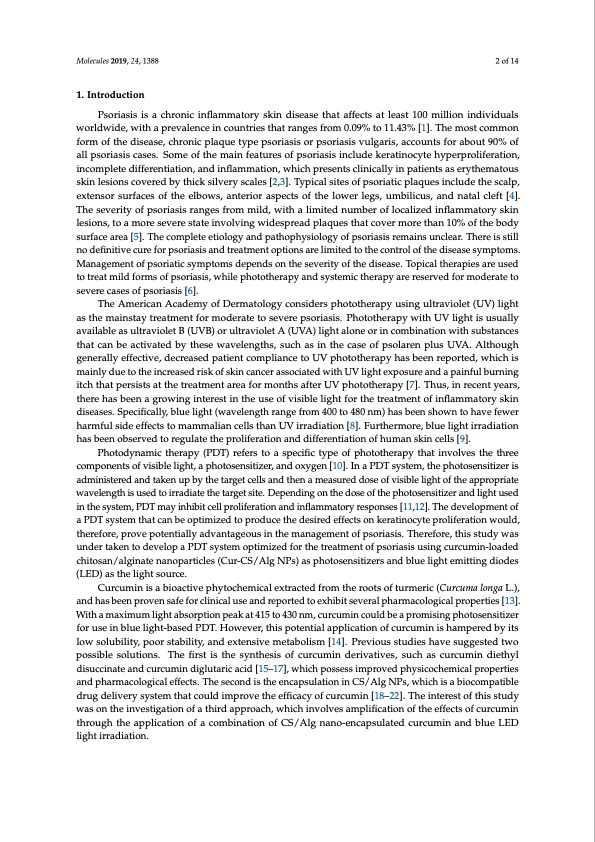
PDF Publication Title:
Text from PDF Page: 002
Molecules 2019, 24, 1388 2 of 14 1. Introduction Psoriasis is a chronic inflammatory skin disease that affects at least 100 million individuals worldwide, with a prevalence in countries that ranges from 0.09% to 11.43% [1]. The most common form of the disease, chronic plaque type psoriasis or psoriasis vulgaris, accounts for about 90% of all psoriasis cases. Some of the main features of psoriasis include keratinocyte hyperproliferation, incomplete differentiation, and inflammation, which presents clinically in patients as erythematous skin lesions covered by thick silvery scales [2,3]. Typical sites of psoriatic plaques include the scalp, extensor surfaces of the elbows, anterior aspects of the lower legs, umbilicus, and natal cleft [4]. The severity of psoriasis ranges from mild, with a limited number of localized inflammatory skin lesions, to a more severe state involving widespread plaques that cover more than 10% of the body surface area [5]. The complete etiology and pathophysiology of psoriasis remains unclear. There is still no definitive cure for psoriasis and treatment options are limited to the control of the disease symptoms. Management of psoriatic symptoms depends on the severity of the disease. Topical therapies are used to treat mild forms of psoriasis, while phototherapy and systemic therapy are reserved for moderate to severe cases of psoriasis [6]. The American Academy of Dermatology considers phototherapy using ultraviolet (UV) light as the mainstay treatment for moderate to severe psoriasis. Phototherapy with UV light is usually available as ultraviolet B (UVB) or ultraviolet A (UVA) light alone or in combination with substances that can be activated by these wavelengths, such as in the case of psolaren plus UVA. Although generally effective, decreased patient compliance to UV phototherapy has been reported, which is mainly due to the increased risk of skin cancer associated with UV light exposure and a painful burning itch that persists at the treatment area for months after UV phototherapy [7]. Thus, in recent years, there has been a growing interest in the use of visible light for the treatment of inflammatory skin diseases. Specifically, blue light (wavelength range from 400 to 480 nm) has been shown to have fewer harmful side effects to mammalian cells than UV irradiation [8]. Furthermore, blue light irradiation has been observed to regulate the proliferation and differentiation of human skin cells [9]. Photodynamic therapy (PDT) refers to a specific type of phototherapy that involves the three components of visible light, a photosensitizer, and oxygen [10]. In a PDT system, the photosensitizer is administered and taken up by the target cells and then a measured dose of visible light of the appropriate wavelength is used to irradiate the target site. Depending on the dose of the photosensitizer and light used in the system, PDT may inhibit cell proliferation and inflammatory responses [11,12]. The development of a PDT system that can be optimized to produce the desired effects on keratinocyte proliferation would, therefore, prove potentially advantageous in the management of psoriasis. Therefore, this study was under taken to develop a PDT system optimized for the treatment of psoriasis using curcumin-loaded chitosan/alginate nanoparticles (Cur-CS/Alg NPs) as photosensitizers and blue light emitting diodes (LED) as the light source. Curcumin is a bioactive phytochemical extracted from the roots of turmeric (Curcuma longa L.), and has been proven safe for clinical use and reported to exhibit several pharmacological properties [13]. With a maximum light absorption peak at 415 to 430 nm, curcumin could be a promising photosensitizer for use in blue light-based PDT. However, this potential application of curcumin is hampered by its low solubility, poor stability, and extensive metabolism [14]. Previous studies have suggested two possible solutions. The first is the synthesis of curcumin derivatives, such as curcumin diethyl disuccinate and curcumin diglutaric acid [15–17], which possess improved physicochemical properties and pharmacological effects. The second is the encapsulation in CS/Alg NPs, which is a biocompatible drug delivery system that could improve the efficacy of curcumin [18–22]. The interest of this study was on the investigation of a third approach, which involves amplification of the effects of curcumin through the application of a combination of CS/Alg nano-encapsulated curcumin and blue LED light irradiation.PDF Image | Synergistic Effects of Photo-Irradiation and Curcumin-Chitosan

PDF Search Title:
Synergistic Effects of Photo-Irradiation and Curcumin-ChitosanOriginal File Name Searched:
molecules-24-01388.pdfDIY PDF Search: Google It | Yahoo | Bing
Cruise Ship Reviews | Luxury Resort | Jet | Yacht | and Travel Tech More Info
Cruising Review Topics and Articles More Info
Software based on Filemaker for the travel industry More Info
The Burgenstock Resort: Reviews on CruisingReview website... More Info
Resort Reviews: World Class resorts... More Info
The Riffelalp Resort: Reviews on CruisingReview website... More Info
| CONTACT TEL: 608-238-6001 Email: greg@cruisingreview.com | RSS | AMP |